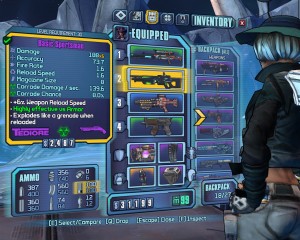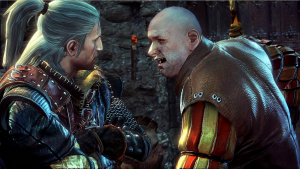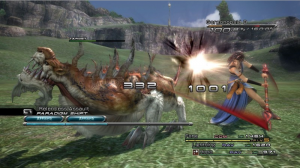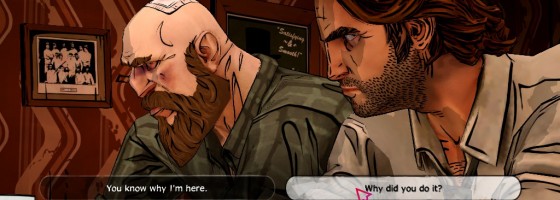Video games are all about giving the player choices: Whether you’re playing Borderlands and have to decide your class to Mass Effect where your choices can affect the plot across multiple games. But not every choice is created equal in game design and today’s post looks at the concept of hard and soft choices.
Personalizing Choices:
Let’s start with soft choices as they are the ones that are easily designed and fit into games. For this post we’re going to define them as the following:
- Soft Choice: A decision that impacts the player’s experience but doesn’t impact the flow of the game or story.
Soft Choices are ways for the player to imprint some of their preferences onto the game. This could be as simple as deciding what color to make their armor to deciding their class in a RPG. I know that some of you reading this are about to comment that choosing a class in a RPG is a big deal to the player, however whether you’re playing as a warrior, thief or mage doesn’t change the level design or what’s going on with rare exceptions.
Soft Choices are great for a game developer as they can give the illusion of choice to the player without having to redesign or alter the game because of it. And the player has the benefit of being able to personalize their experience to some extent which can be a great way to get them invested in the game.
Soft choices can also impact the plot but on a small scale. Perhaps a character or detail will be different in major scenes or the flow of the story will slightly change depending on the soft choice to a certain extent before returning back to the main plot.
A major example of this would be in the storytelling that is happening at Telltale Games with their recent titles. Within each episode of a season, the player is free to choose how the character reacts to a situation; their reaction has no impact on the overall plot but gives the player a chance to have some input in the story.

Choices that only impact how the player goes through the game or affects the plot short term, would be considered a soft choice
The problem with soft choices is that they can be seen as a cheat by the game developer in a sense of boasting that the player can choose how the game plays out.
Soft choices only offer minor impacts on the overall plot at best and it’s like the difference between angrily breaking open a door or kicking a door open in frustration.
One example would be Deus Ex Human Revolution that boasted about how the player could control the story through their choices. However all the choices the player made meant nothing when it came to advancing the plot or even affecting what came next. The first area alluded to the player’s actions affecting how people and events would look at them, but this quickly went away. The only choice the player had that affected the plot was the end where they had to literally pick an ending.
Another part of soft choices is the use of a morality slider that is affected by soft choices. This is a case where a bunch of soft choices can eventually turn into a hard choice. However what ends up happening is that you can invalidate your soft choices by performing other choices so that in the end the only thing that is affecting the plot is where the slider is at.
Next, we turn to hard choices and what they mean for a game designer.
Moving Things Along:
For this post we’re going to define hard choices as the following:
- Hard Choice: A decision that directly impacts the game’s story or flow while possibly locking other choices from the player.
Hard choices are the ways for the player to actively affect how the game plays out. Going back to the morality slider example, a hard choice is when the game uses the slider to determine what your final path through the game is like.
Hard choices generally are points of no returns that will lock the player to a specific path. This also means the developer will have to write or amend parts of the story based on what the player decides at specific hard choices.
An example of this would be the underrated game Alpha Protocol from a few years ago. Here, every time the player chose a mission to go on would affect subsequent missions and the overall plot based on the order that they chose and what they did on each mission. The game also had soft choices that defined the player’s preferences based on how violent or stealthfully they would get through a level.

Choices that permanently alter the story or even the character themselves would be considered hard choices
For each hard choice the game developer wants in their game, the game’s plot will expand and branch out in different directions based on the number of hard choices.
This was one of the high marks of the Mass Effect trilogy and how the game’s plot would change throughout each title depending on the player’s response at certain hard choices. But the series also had soft choices that let them define their version of Sheppard.
One thing you want to watch out for is having hard choices that eventually petered out back to soft choices. An example of this would be from The Walking Dead season one which I have to lightly spoil.
In the first season you have to make a hard choice at the start to determine who lives or dies. The saved person would stick with you throughout the season until an event happens that gets them killed. The problem is that the murder event happens no matter what regardless of your choices at the same point every time. In this case the hard choice at the start of the season becomes relegated to a soft choice to serve the overall plot.
The Witcher 2 was an example of a game that combined soft and hard choices effectively by splitting them between choices that affected the story/characters of a chapter and those that would alter the overall plot and grand story of the game. This gave the developers a lot of leeway in creating multiple soft choices that the player would have to interact with constantly to keep the player invested, while having larger points to move the story along.
Remember, a hard choice actively changes the flow of the game and it’s important not to have too many. Every choice creates another plot and experience variant that you as the game developer will have to create. This can become even more complicated when you have hard choices on top of hard choices which further add to the number of paths that have to be designed. Having too many hard choices is just as bad as having too many soft except this time it’s on the developer’s end.
This is why most games set only a few hard choices throughout the game and give the player the illusion of choice via numerous soft choices.
Questionable Choices:
Having choices in your game doesn’t automatically make it better or worse as there are plenty of games designed around a set experience like Mario, Diablo and so on. But if you are promising the player that they will have a role to play in how the story unfolds, then you need to develop meaningful choices both to the plot and the player.

Most JRPGs focus on a strict designer written plot but fill the game with soft choices of party development to give the player some control over the experience
Soft choices generally provide an impact to the player while hard choices are more about the plot and balancing them both is needed to make an effective story.
Without soft choices the player won’t become invested in their character and without hard choices it will be harder for them to care about the plot.
If you’re going for a linear experience with a focus on gameplay over narrative or a story entirely controlled by the designer, then soft choices are going to be the better fit. Hard choices are a lot harder to design as evident by the fact that we don’t see too many titles go for them, but a developer who can integrate both into their game effectively can have one amazing story to tell.

